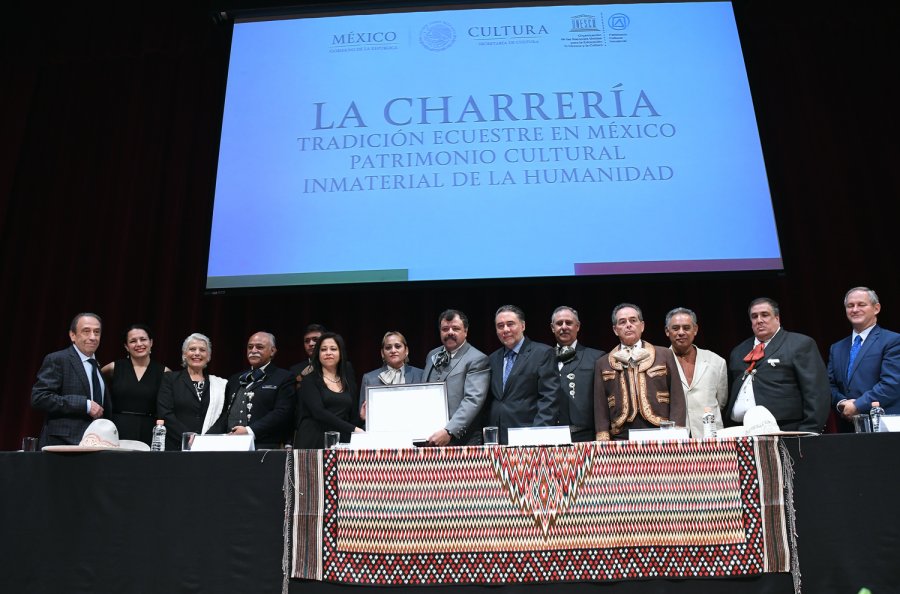Noticias
Charrería recognized as World Cultural Heritage
September 13, 2017Just one day after the Grito de Independencia was celebrated in Mexico, the art of La Charrería became the eighth cultural manifestation of our country to be registered by the United Nations Educational, Scientific and Cultural Organization (UNESCO) as Intangible Cultural Heritage of Humanity.
The certificate of this distinction was presented this Thursday at the National Museum of Anthropology with the presence of Jorge Gutiérrez, Undersecretary of Cultural Diversity and Promotion of Reading, representing President Enrique Peña Nieto; Alma Lara, Administrative Officer of the UNESCO Office in Mexico, representing its director Nuria Sanz; Myriam Vachez, Secretary of Culture of Jalisco and Arturo Jiménez Mangas, director of the Association Charros de Mexico.
The secretary of Culture, María Cristina García Cepeda, sent a message of congratulations for this declaration; García Cepeda is on a tour of work in the states of Chiapas and Oaxaca, supervising the heritage affected by the recent earthquake that afflicted these places.
Jorge Gutiérrez celebrated that this declaration, which united civil society and institutions to recognize La Charrería as Intangible Cultural Heritage of Humanity, is added to the list of six others that recognize traditions that are part of a past that remains alive in Mexico
He said that La Charrería, together with the festivals dedicated to the dead, the places of memories and Otomí and Chichimeca living traditions in Colimán, the Peña de Bernal, the ritual ceremony of flyers, the traditional Mexican cuisine, La Pirekua, a purepecha traditional song; the Parachicos in the traditional festival of Chiapa de Corzo and mariachi are part of the heritage that makes us proud and place us in first position in America regarding the assets inscribed as heritage and the seventh worldwide.
He said that in order to protect La Charrería, which together with other expressions make up the face and identity of Mexico, work is being done to establish the Commission on Intangible Cultural Heritage, whose mission will be to identify, register, recognize, disseminate, value and safeguard Mexico's intangible heritage.
"La Charrería, practiced in Mexico and abroad, promotes values of solidarity, equality and equity. It's a celebration of color and dexterity that is also found in Mexican art, in popular song, in the images of our cinema, in the party and serenade and in love and community celebration”, added Gutiérrez Vázquez.
During the ceremony, the Undersecretary of Cultural Diversity and Promotion of Reading, delivered facsimile copies of the UNESCO declaration to Pedro Rocha, of the American Charrería Society; Pedro Martínez, of the Charros de Jalisco Association; José Luis Díaz Pérez, of the Charros de la Cuenca del Papaloapan Association; José de Jesús Salazar, of the Charros de Morelia Association; Joaquín Valenzuela, from the Association of Regional Charros of Querétaro; Juan de Dios Moreno, from the Association of Charros de la Tuna Alta, Jalisco; Basurto García Rojas, from the Association of Charros de Polotitlán; José Lugo, from the Association of Charros de Huichapan and Alejandro de la Torre, representative of the artisan community, among others.
Alma Lara, UNESCO's administrative official in Mexico, on behalf of its director Nuria Sanz, celebrated that the Department of Culture of the Government of the Republic supported the presentation of the dossier with folio 1108 to begin the registration of this inscription of La Charrería as Intangible Cultural Heritage of Humanity.
"It was necessary to unravel the symbolic framework of this tradition so that the people of Mexico and the world could understand that behind this art is embodied the hard work to survive in the countryside and a long history of equestrian uses to protect the peoples and advance the novohispana economy”.
She expressed that riding the horse was a conquest of progress by the peasants, which referred to a cultural hybridization that later left an imprint on music, craftsmanship, goldsmithing, smithery, weaving and many other expressions.
"La Charrería required the elaboration of numerous accessories such as the saddle, the rope, and a baroque dress that reflects the identity of a people who built their faces. Today it is a dialogue between generations, a fabric that unites people from the countryside and cities and which today emerges as a world heritage site because of its cross-cutting, as a living knowledge in symbiosis with nature, its environment and society".
The registration of this event was approved during the Eleventh Session of the Intergovernmental Committee for the Safeguarding of the Intangible Cultural Heritage, held in Addis Ababa, Ethiopia, following a five-year process of efforts by the Department of Culture, the Department of Foreign Affairs, the National Institute of Anthropology, the General Directorate of Popular, Indigenous and Urban Cultures, and the National Charros Association.
Myriam Vachez, secretary of Culture of Jalisco, read a text from the governor Aristóteles Sandoval in which it is affirmed that this tradition is part of our daily life and breathes in our environment to give dignity to our culture with the presence of more than 120 charros associations.
"All the elements that make up the cultural mosaic of the charrería are a tradition in itself and enrich our culture, so we must follow the plan of safeguarding to keep this tradition alive”.
Finally, Manuel Basurto, vice-president of the National Council of La Charrería, reminded that in 2010 efforts were initiated with INAH and Unesco to achieve this declaration and help ensure the future of this tradition in our country, which was culturally revised as a symbol of Mexico.
"Before, the figure of the charro was an image of our nation, but today the new generations must know these ideals and values beyond the outside influences in which they are immersed every day. The responsibility to protect La Charrería belongs to all of us and our unity must be an example to achieve the country's unity towards the future”.
Mexico,Distrito Federal
